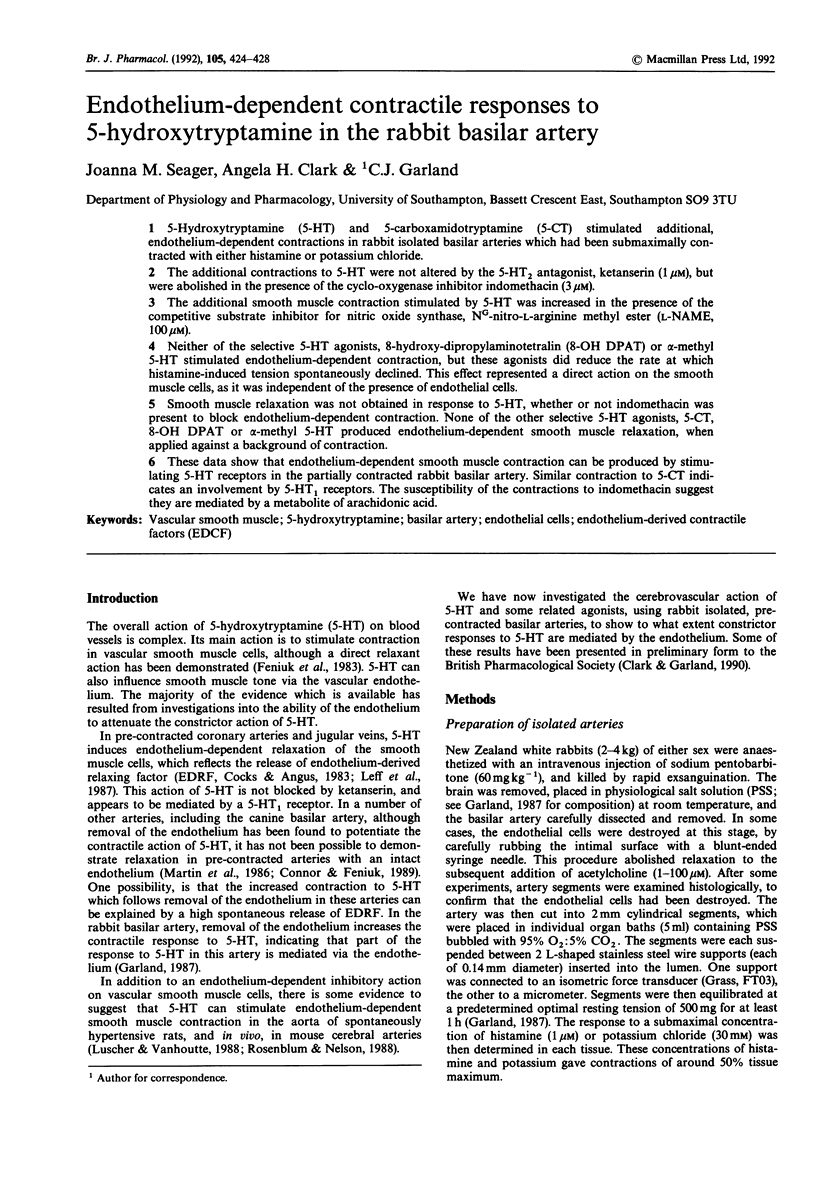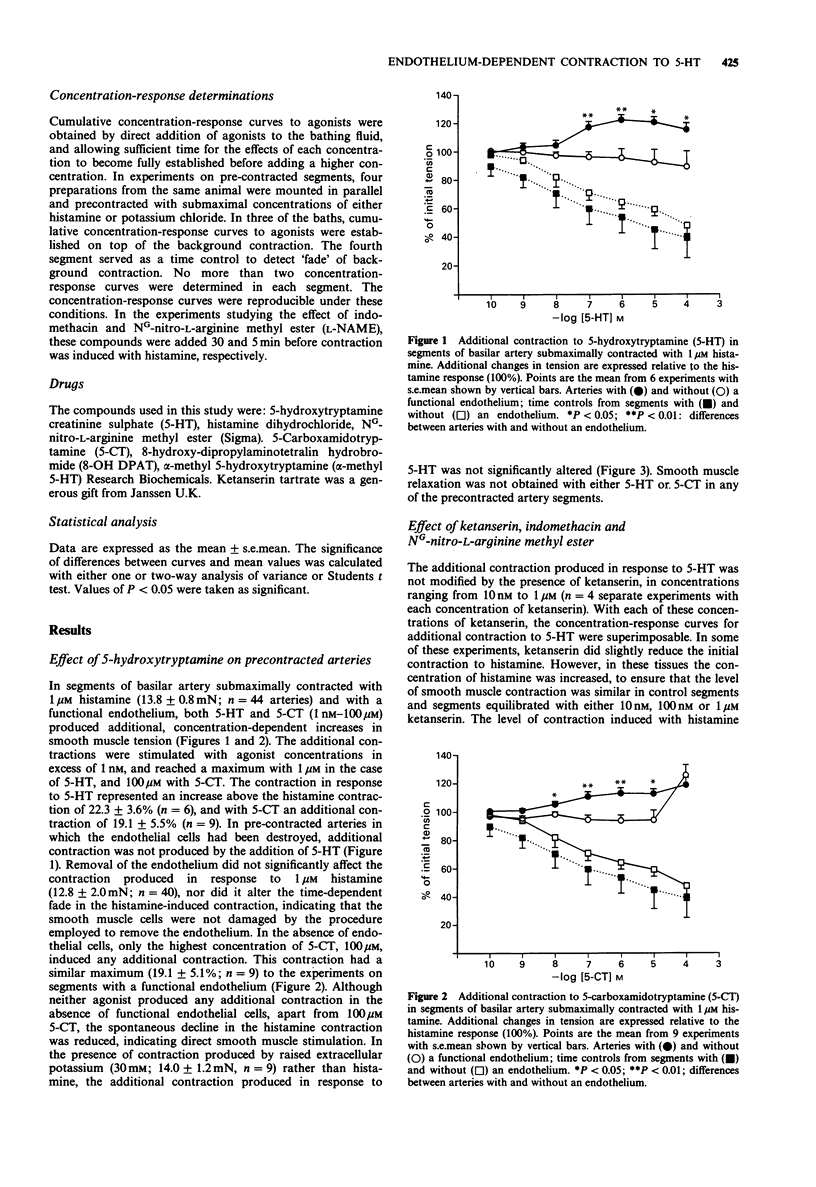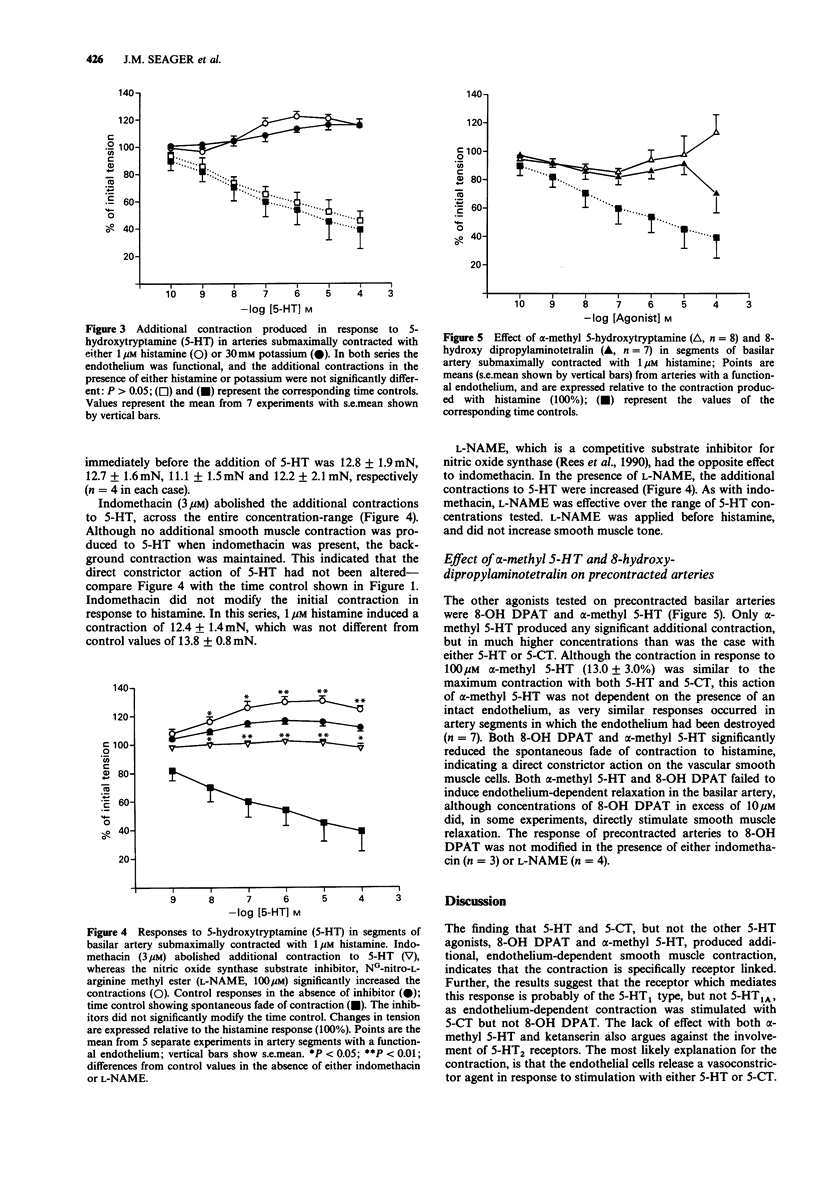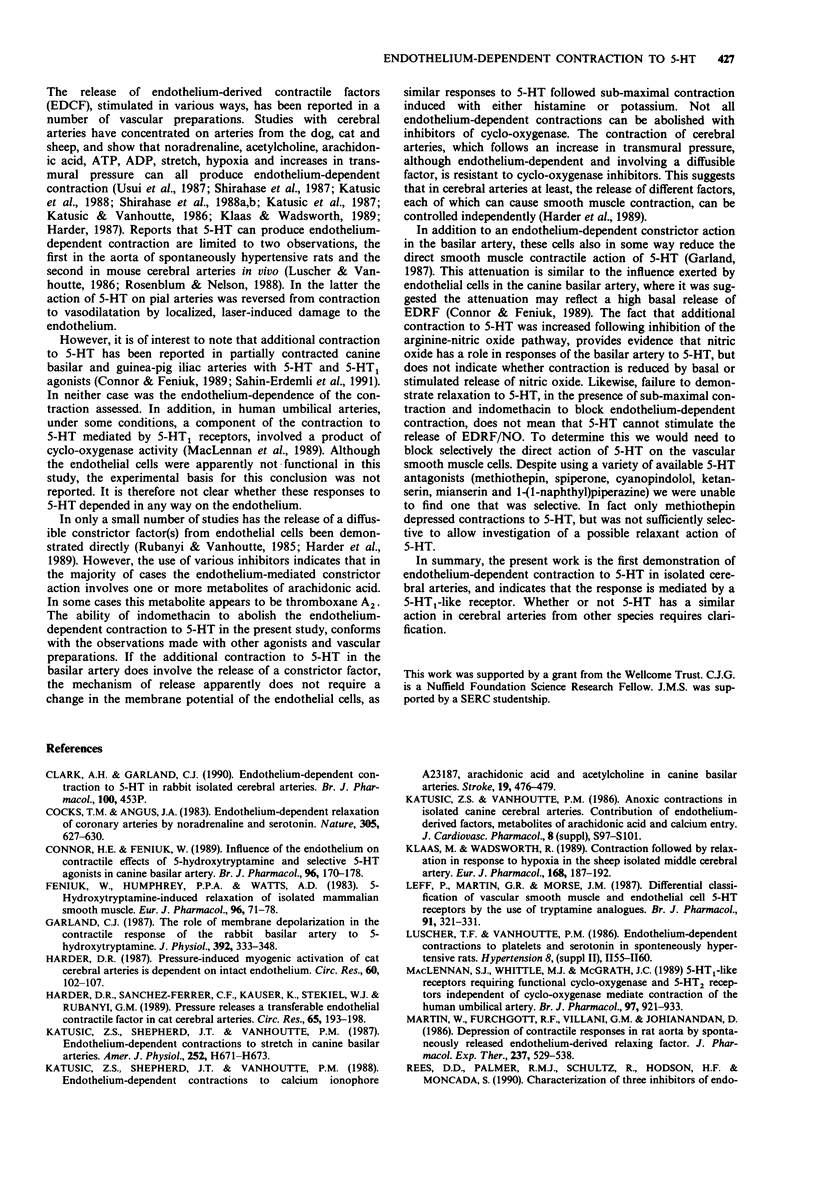Abstract
1 5-Hydroxytryptamine (5-HT) and 5-carboxamidotryptamine (5-CT) stimulated additional, endothelium-dependent contractions in rabbit isolated basilar arteries which had been submaximally contracted with either histamine or potassium chloride. 2 The additional contractions to 5-HT were not altered by the 5-HT2 antagonist, ketanserin (1 microM), but were abolished in the presence of the cyclo-oxygenase inhibitor indomethacin (3 microM). 3 The additional smooth muscle contraction stimulated by 5-HT was increased in the presence of the competitive substrate inhibitor for nitric oxide synthase, NG-nitro-L-arginine methyl ester (L-NAME, 100 microM). 4 Neither of the selective 5-HT agonists, 8-hydroxy-dipropylaminotetralin (8-OH DPAT) or alpha-methyl 5-HT stimulated endothelium-dependent contraction, but these agonists did reduce the rate at which histamine-induced tension spontaneously declined. This effect represented a direct action on the smooth muscle cells, as it was independent of the presence of endothelial cells. 5 Smooth muscle relaxation was not obtained in response to 5-HT, whether or not indomethacin was present to block endothelium-dependent contraction. None of the other selective 5-HT agonists, 5-CT, 8-OH DPAT or alpha-methyl 5-HT produced endothelium-dependent smooth muscle relaxation, when applied against a background of contraction. 6 These data show that endothelium-dependent smooth muscle contraction can be produced by stimulating 5-HT receptors in the partially contracted rabbit basilar artery. Similar contraction to 5-CT indicates an involvement by 5-HT1 receptors. The susceptibility of the contractions to indomethacin suggest they are mediated by a metabolite of arachidonic acid.
Full text
PDF




Selected References
These references are in PubMed. This may not be the complete list of references from this article.
- Cocks T. M., Angus J. A. Endothelium-dependent relaxation of coronary arteries by noradrenaline and serotonin. Nature. 1983 Oct 13;305(5935):627–630. doi: 10.1038/305627a0. [DOI] [PubMed] [Google Scholar]
- Connor H. E., Feniuk W. Influence of the endothelium on contractile effects of 5-hydroxytryptamine and selective 5-HT agonists in canine basilar artery. Br J Pharmacol. 1989 Jan;96(1):170–178. doi: 10.1111/j.1476-5381.1989.tb11797.x. [DOI] [PMC free article] [PubMed] [Google Scholar]
- Feniuk W., Humphrey P. P., Watts A. D. 5-Hydroxytryptamine-induced relaxation of isolated mammalian smooth muscle. Eur J Pharmacol. 1983 Dec 9;96(1-2):71–78. doi: 10.1016/0014-2999(83)90530-7. [DOI] [PubMed] [Google Scholar]
- Garland C. J. The role of membrane depolarization in the contractile response of the rabbit basilar artery to 5-hydroxytryptamine. J Physiol. 1987 Nov;392:333–348. doi: 10.1113/jphysiol.1987.sp016783. [DOI] [PMC free article] [PubMed] [Google Scholar]
- Harder D. R. Pressure-induced myogenic activation of cat cerebral arteries is dependent on intact endothelium. Circ Res. 1987 Jan;60(1):102–107. doi: 10.1161/01.res.60.1.102. [DOI] [PubMed] [Google Scholar]
- Harder D. R., Sanchez-Ferrer C., Kauser K., Stekiel W. J., Rubanyi G. M. Pressure releases a transferable endothelial contractile factor in cat cerebral arteries. Circ Res. 1989 Jul;65(1):193–198. doi: 10.1161/01.res.65.1.193. [DOI] [PubMed] [Google Scholar]
- Katusic Z. S., Shepherd J. T., Vanhoutte P. M. Endothelium-dependent contraction to stretch in canine basilar arteries. Am J Physiol. 1987 Mar;252(3 Pt 2):H671–H673. doi: 10.1152/ajpheart.1987.252.3.H671. [DOI] [PubMed] [Google Scholar]
- Katusic Z. S., Shepherd J. T., Vanhoutte P. M. Endothelium-dependent contractions to calcium ionophore A23187, arachidonic acid, and acetylcholine in canine basilar arteries. Stroke. 1988 Apr;19(4):476–479. doi: 10.1161/01.str.19.4.476. [DOI] [PubMed] [Google Scholar]
- Katusic Z. S., Vanhoutte P. M. Anoxic contractions in isolated canine cerebral arteries: contribution of endothelium-derived factors, metabolites of arachidonic acid, and calcium entry. J Cardiovasc Pharmacol. 1986;8 (Suppl 8):S97–101. [PubMed] [Google Scholar]
- Klaas M., Wadsworth R. Contraction followed by relaxation in response to hypoxia in the sheep isolated middle cerebral artery. Eur J Pharmacol. 1989 Sep 13;168(2):187–192. doi: 10.1016/0014-2999(89)90564-5. [DOI] [PubMed] [Google Scholar]
- Knudsen T., Berthelsen H. C., Johansen T. Inhibition of Na(+) -K+ pump activity by divalent cations in intact peritoneal mast cells of the rat. Br J Pharmacol. 1990 Jul;100(3):453–456. doi: 10.1111/j.1476-5381.1990.tb15827.x. [DOI] [PMC free article] [PubMed] [Google Scholar]
- Leff P., Martin G. R., Morse J. M. Differential classification of vascular smooth muscle and endothelial cell 5-HT receptors by use of tryptamine analogues. Br J Pharmacol. 1987 Jun;91(2):321–331. doi: 10.1111/j.1476-5381.1987.tb10287.x. [DOI] [PMC free article] [PubMed] [Google Scholar]
- MacLennan S. J., Whittle M. J., McGrath J. C. 5-HT1-like receptors requiring functional cyclo-oxygenase and 5-HT2 receptors independent of cyclo-oxygenase mediate contraction of the human umbilical artery. Br J Pharmacol. 1989 Jul;97(3):921–933. doi: 10.1111/j.1476-5381.1989.tb12033.x. [DOI] [PMC free article] [PubMed] [Google Scholar]
- Martin W., Furchgott R. F., Villani G. M., Jothianandan D. Depression of contractile responses in rat aorta by spontaneously released endothelium-derived relaxing factor. J Pharmacol Exp Ther. 1986 May;237(2):529–538. [PubMed] [Google Scholar]
- Rees D. D., Palmer R. M., Schulz R., Hodson H. F., Moncada S. Characterization of three inhibitors of endothelial nitric oxide synthase in vitro and in vivo. Br J Pharmacol. 1990 Nov;101(3):746–752. doi: 10.1111/j.1476-5381.1990.tb14151.x. [DOI] [PMC free article] [PubMed] [Google Scholar]
- Rosenblum W. I., Nelson G. H. Endothelium-dependent constriction demonstrated in vivo in mouse cerebral arterioles. Circ Res. 1988 Oct;63(4):837–843. doi: 10.1161/01.res.63.4.837. [DOI] [PubMed] [Google Scholar]
- Rubanyi G. M., Vanhoutte P. M. Hypoxia releases a vasoconstrictor substance from the canine vascular endothelium. J Physiol. 1985 Jul;364:45–56. doi: 10.1113/jphysiol.1985.sp015728. [DOI] [PMC free article] [PubMed] [Google Scholar]
- Sahin-Erdemli I., Hoyer D., Stoll A., Seiler M. P., Schoeffter P. 5-HT1-like receptors mediate 5-hydroxytryptamine-induced contraction of guinea-pig isolated iliac artery. Br J Pharmacol. 1991 Feb;102(2):386–390. doi: 10.1111/j.1476-5381.1991.tb12183.x. [DOI] [PMC free article] [PubMed] [Google Scholar]
- Shirahase H., Fujiwara M., Usui H., Kurahashi K. A possible role of thromboxane A2 in endothelium in maintaining resting tone and producing contractile response to acetylcholine and arachidonic acid in canine cerebral arteries. Blood Vessels. 1987;24(3):117–119. doi: 10.1159/000158682. [DOI] [PubMed] [Google Scholar]
- Shirahase H., Usui H., Manabe K., Kurahashi K., Fujiwara M. An endothelium-dependent contraction induced by A-23187, a Ca++ ionophore in canine basilar artery. J Pharmacol Exp Ther. 1988 Nov;247(2):701–705. [PubMed] [Google Scholar]
- Shirahase H., Usui H., Manabe K., Kurahashi K., Fujiwara M. Endothelium-dependent contraction and -independent relaxation induced by adenine nucleotides and nucleoside in the canine basilar artery. J Pharmacol Exp Ther. 1988 Dec;247(3):1152–1157. [PubMed] [Google Scholar]
- Usui H., Kurahashi K., Shirahase H., Fukui K., Fujiwara M. Endothelium-dependent vasocontraction in response to noradrenaline in the canine cerebral artery. Jpn J Pharmacol. 1987 Jun;44(2):228–231. doi: 10.1254/jjp.44.228. [DOI] [PubMed] [Google Scholar]


